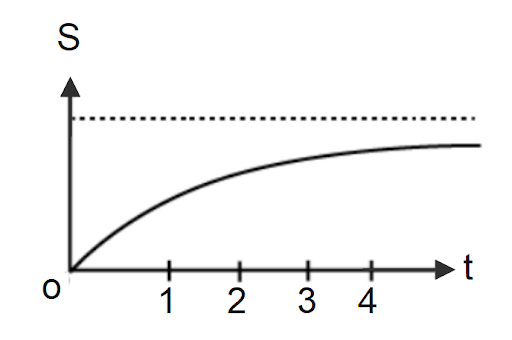
The displacement of a particle as a function of time as shown in the figure. It indicates

A. the particle starts with a certain velocity, but the motion is retarded and finally the particle stops.
B. the velocity of the particle decreases.
C. the acceleration of the particle is in the opposite direction to the velocity.
D. the particle starts with a constant velocity, the motion is accelerated and finally the particle moves with another constant velocity.
Answer
174.3k+ views
Hint: In this question, we are given a figure in which displacement of a particle is shown. We have to choose the option which our figure satisfies. We see that at origin slope is not zero and with the increase in time slope is decreasing. Then we choose the option which our figure satisfies.
Complete step by step solution:
We are given a figure in which the displacement of a particle as a function of time. We know that the slope of the s-t graph represents velocity. Initially at the origin, slope is not zero, so the particle has some initial velocity. With the increasing time we see that the slope is decreasing and finally the slope becomes zero, so the particle stops finally. As the magnitude of the velocity is decreasing, so the velocity and the acceleration will be in opposite directions.
Hence, options A,B and C are correct.
Note: We say that the displacement varies with time or is a function of time t.
We know the equation $d=vt+\dfrac{1}{2}a{{t}^{2}}$$d=vt+\dfrac{1}{2}a{{t}^{2}}$
This clearly shows that the displacement depends upon time.
Complete step by step solution:
We are given a figure in which the displacement of a particle as a function of time. We know that the slope of the s-t graph represents velocity. Initially at the origin, slope is not zero, so the particle has some initial velocity. With the increasing time we see that the slope is decreasing and finally the slope becomes zero, so the particle stops finally. As the magnitude of the velocity is decreasing, so the velocity and the acceleration will be in opposite directions.
Hence, options A,B and C are correct.
Note: We say that the displacement varies with time or is a function of time t.
We know the equation $d=vt+\dfrac{1}{2}a{{t}^{2}}$$d=vt+\dfrac{1}{2}a{{t}^{2}}$
This clearly shows that the displacement depends upon time.
Recently Updated Pages
JEE Main Physics Mock Test 2025

JEE Main Maths Mock Test 2025: FREE Online Mock Test Series

JEE Main Chemistry Mock Test 2025

JEE Main Hydrocarbons Mock Test 2025-26: Free Practice Online

JEE Main 2025-26 Mock Test: Organic Compounds Containing Nitrogen

JEE Main 2025-26 Mock Test: Organic Compounds Containing Halogens

Trending doubts
JEE Main 2025 Session 2: Application Form (Out), Exam Dates (Released), Eligibility, & More

Displacement-Time Graph and Velocity-Time Graph for JEE

Uniform Acceleration

JEE Main 2025: Derivation of Equation of Trajectory in Physics

Learn About Angle Of Deviation In Prism: JEE Main Physics 2025

Instantaneous Velocity - Formula based Examples for JEE

Other Pages
NCERT Solutions For Class 11 Physics Chapter 2 Motion In A Straight Line - 2025-26

NCERT Solutions For Class 11 Physics Chapter 1 Units and Measurements - 2025-26

JEE Advanced Marks vs Ranks 2025: Understanding Category-wise Qualifying Marks and Previous Year Cut-offs

Units And Measurements Class 11 Physics Chapter 1 CBSE Notes - 2025-26

NCERT Solutions For Class 11 Physics Chapter 3 Motion In A Plane - 2025-26

Motion in a Straight Line Class 11 Physics Chapter 2 CBSE Notes - 2025-26




